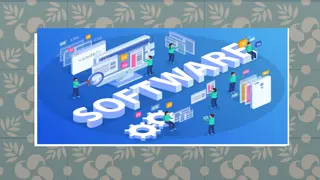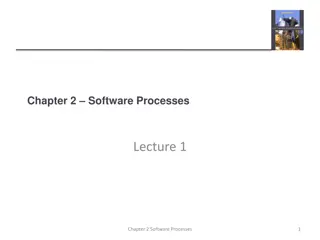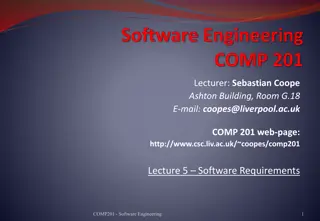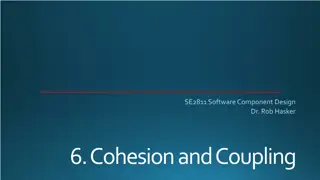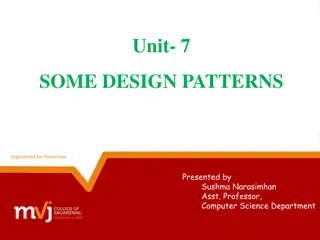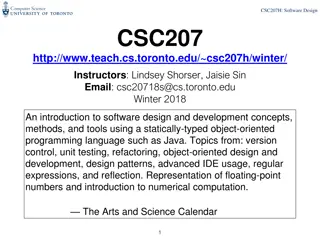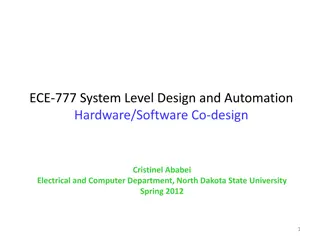SE2811 Software Component Design Overview
This course covers software component design, design patterns, object-oriented design, algorithms, and opportunities for reuse in systems design. It emphasizes the importance of domain-level design and provides insights into solving core problems through reusable classes.
Download Presentation

Please find below an Image/Link to download the presentation.
The content on the website is provided AS IS for your information and personal use only. It may not be sold, licensed, or shared on other websites without obtaining consent from the author.If you encounter any issues during the download, it is possible that the publisher has removed the file from their server.
You are allowed to download the files provided on this website for personal or commercial use, subject to the condition that they are used lawfully. All files are the property of their respective owners.
The content on the website is provided AS IS for your information and personal use only. It may not be sold, licensed, or shared on other websites without obtaining consent from the author.
E N D
Presentation Transcript
SE2811 Software Component Design Dr. Josiah Yoder (Throughout this course, many slides originally by Dr. Hasker, Dr. Hornick, and Dr. Urbain) 1. Where to start
SE 2811: Software Component Design Design Patterns Domain-level Object-Oriented Design (OOD)
SE 2811: Software Component Design Algorithms CS 2852 Design? Opportunities for reuse Classic reuse models: requirements, algorithms Requirements SE 3821 Systems
SE 2811: Software Component Design Algorithms CS 2852 Design: SE 2811 Opportunities for reuse Classic reuse models: requirements, algorithms 2811: reusing designs Requirements SE 3821 Systems
Domain-Level Design There are many ways to solve a problem Solutions change over time But the core problems don t change Having classes that describe the core problem makes them more reuasable, too.
Administrative Break Syllabus Safety Review Review Syllabus
SE 2811: Software Component Design Algorithms CS 2852 Design: SE 2811 Opportunities for reuse Classic reuse models: requirements, algorithms 2811: reusing designs Requirements SE 3821 Systems
SE 2811: Software Component Design Algorithms CS 2852 Design: SE 2811 Opportunities for reuse Classic reuse models: requirements, algorithms 2811: reusing designs 1994: Gang of 4 Gamma, Helm, Johnson, Vlissides Requirements SE 3821 Systems
SE 2811: Software Component Design Algorithms CS 2852 Design: SE 2811 Opportunities for reuse Classic reuse models: requirements, algorithms 2811: reusing designs 1994: Gang of 4 Gamma, Helm, Johnson, Vlissides Requirements SE 3821 Design pattern: general, reusable solution to a commonly occurring problem in software design Systems
A real-life example (#1) How to get from Milwaukee to Chicago? Identify at least four methods What are common elements? What can differ? How do we compare them? Are these algorithms? Algorithm: sequence of steps to be followed to calculate a result
Example #2 Problem: Workplace, home traffic pattern: travel to frequently accessed objects If objects scattered, flow of life is awkward Items forgotten, misplaced
Example #2 Problem: Workplace, home traffic pattern: travel to frequently accessed objects If objects scattered, flow of life is awkward Items forgotten, misplaced Solution: Waist-high shelves around at least part of main rooms in which people live & work They should be long, 22-40 cm deep Shelves or cupboard underneath Interrupt shelf for seats, windows, doors
Example #2 Note features: Shelf color, material not important to the structure Not an algorithm/not blueprints Architectural design pattern Are there times when the pattern is a poor choice? Each pattern: Solves a recurring problem Tradeoffs: advantages, disadvantages to applying
Software example public class StereoController { private Volume volume; private Equalizer equalizer; public StereoController(Volume volume, Equalizer equalizer) { this.volume = volume; this.equalizer = equalizer; } public changeVolume(int ticks) { volume.adjust(ticks); } public changeChannel(int channel, int ticks) { if ( equalizer != null ) equalizer.getChannel(channel).adjust(ticks); } }
Software example Models core elements of stereo: volume control, equalizer public class StereoController { private Volume volume; private Equalizer equalizer; public StereoController(Volume volume, Equalizer equalizer) { this.volume = volume; this.equalizer = equalizer; } public changeVolume(int ticks) { volume.adjust(ticks); } public changeChannel(int channel, int ticks) { if ( equalizer != null ) equalizer.getChannel(channel).adjust(ticks); } }
Software example public class StereoController { private Volume volume; private Equalizer equalizer; public StereoController(Volume volume, Equalizer equalizer) { this.volume = volume; this.equalizer = equalizer; } public changeVolume(int ticks) { volume.adjust(ticks); } public changeChannel(int channel, int ticks) { if ( equalizer != null ) equalizer.getChannel(channel).adjust(ticks); } } Models core elements of stereo: volume control, equalizer If statement: allows stereo without equalizer Problem: will need to check every use Violates an OO principle: don t repeat yourself Why is repetition a problem? How can we remove it?
Solution: create do nothing classes public class Equalizer { public final int MAX_CHANNEL = 6; private Level[] channels = new Level[MAX_CHANNEL]; public Equalizer() { } public Level getChannel(int i) { return channels[i]; } } public class NullLevelObject { public adjust(int value) { } } NullEqualizerObject: returned channel does nothing on adjust public class NullEqualizerObject { private NullLevelObject nullLevel = new NullLevelObject(); public Level getChannel(int i) { return nullLevel; } }
public class StereoController { private Volume volume; private Equalizer equalizer; public StereoController(Volume volume, Equalizer equalizer) { this.volume = volume; this.equalizer = equalizer; } public changeVolume(int ticks) { volume.adjust(ticks); } public changeChannel(int channel, int ticks) { equalizer.getChannel(channel).adjust(ticks); } } Removing the `if new StereoController(new Volume(), new NullEqualizerObject()); Stereo without equalizer:
Null Object Pattern Create a class that mirrors another Each operation does nothing Value returning operations: return something reasonable Use this class wherever might have a check for null Advantage: avoid lots of if ( x != null ) Disadvantage: more classes to write Clearly a bad idea in this case! Possibly useful for full Stereo Also: may delay raising an error: fail fast!
SE-2811 Software Component Design See syllabus at https://faculty-web.msoe.edu/hasker/se2811
Review Design patterns: capturing frequent design solutions Reusing designs in addition to requirements, algorithms Null Object Pattern: avoiding if ( x == null ) through do nothing classes Next: Adapter Pattern


